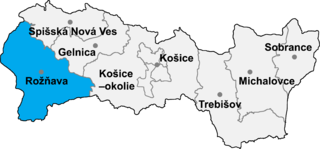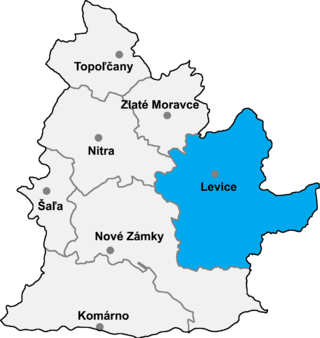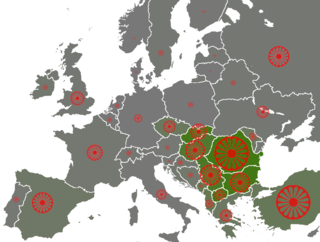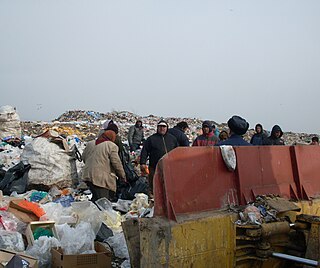
The Romani, colloquially known as the Roma, are an Indo-Aryan ethnic group and traditionally nomadic itinerants. They live in Europe and Anatolia, and have diaspora populations located worldwide with significant concentrations in the Americas.

Ústí nad Labem is a city in the Czech Republic. It has about 92,000 inhabitants and is the capital of the Ústí nad Labem Region. It is a major industrial centre and, besides being an active river port, is an important railway junction.

Košice is the largest city in eastern Slovakia. It is situated on the river Hornád at the eastern reaches of the Slovak Ore Mountains, near the border with Hungary. With a population of approximately 230,000, Košice is the second-largest city in Slovakia, after the capital Bratislava.

Baia Mare is a municipality along the Săsar River, in northwestern Romania; it is the capital of Maramureș County. The city lies in the region of Maramureș, a subregion of Transylvania. It is situated about 600 kilometres from Bucharest, 70 km (43 mi) from the border with Hungary, and 50 km (31 mi) from the border with Ukraine.

Levoča is a town in the Prešov Region of eastern Slovakia with a population of 14,700. The town has a historic center with a well preserved town wall, a Gothic church with the highest wooden altar in the world, carved by Master Pavol of Levoča, and many other Renaissance buildings.

Lupeni is a mining city in the Jiu Valley in Hunedoara County, Romania, in the historical region of Transylvania. It is one of the oldest and largest cities in the Jiu Valley. It is located on the banks of the West Jiu river within the Jiu Valley, at a height varying between 630 metres (2,070 ft) and 760 metres (2,490 ft). The distance from Lupeni to Petroșani is 18 kilometres (11 mi) (DN66A), and to Deva is 114 kilometres (71 mi).
Romani people, traditionally Țigani, constitute one of Romania's largest minorities. According to the 2011 census, their number was 621,573 people or 3.3% of the total population, being the second-largest ethnic minority in Romania after Hungarians. There are different estimates about the size of the total population of people with Romani ancestry in Romania, varying from 4.6 per cent to over 10 percent of the population, because many people of Romani descent do not declare themselves Romani. For example, the Council of Europe estimates that approximately 1.85 million Roma live in Romania, a figure equivalent to 8.32% of the population.

Kráľovský Chlmec is a town in the Trebišov District in the Košice Region of south-eastern Slovakia. It has a population of around 8,000.

Medzev, also known as Metzenseifen is a town and large municipality in Košice-okolie District in the Košice Region of eastern Slovakia. It is one of several towns in Bodva Valley. Other towns in Bodva Valley include: Jasov, Lucia Bania, Vyšný Medzev, and Stos. Historically, It belonged to one of the original mountain towns in the Lower Zips/Dolný Spis: Gelnica/Göllnitz, Smolník/Schmöllnitz, Nálepkovo/Wagendrüssel, Krompachy/Krompach, Mníšek nad Hnilcom/Einsiedel, Švedlár/Schwedler.

Moldava nad Bodvou is a town and municipality in Košice-okolie District in the Košice Region of eastern Slovakia.

Kunova Teplica is a village and municipality in the Rožňava District in the Košice Region of middle-eastern Slovakia.

Hronovce is a village and municipality in the Levice District in the Nitra Region of Slovakia.

Anti-Romani sentiment is a form of anti-Indian sentiment which consists of hostility, prejudice, discrimination, racism and xenophobia which is specifically directed at Romani people. Non-Romani itinerant groups in Europe such as the Yenish, Irish and Highland Travellers are frequently given the name "gypsy" and as a result, they are frequently confused with the Romani people. As a result, sentiments which were originally directed at the Romani people are also directed at other traveler groups and they are frequently referred to as "antigypsy" sentiments.

Romani people are an ethnic minority in the Czech Republic, currently making up 2–3% of the population. Originally migrants from North Western India sometime between the 6th and 11th centuries, they have long had a presence in the region. Since the creation of Czechoslovakia in 1918, the Romani population have experienced considerable hardship, having been a main target of Nazi extermination programs during World War II, and the subject of forced relocation, sterilisation, and other radical social policies during the Communist era. In the successor state, the Czech Republic, challenges remain for the Romani population with respect to education and poverty, and there are frequent tensions with the white majority population over issues including crime and integration.

The Roma people have several distinct populations, the largest being the Roma and the Iberian Calé or Caló, who reached Anatolia and the Balkans in the early 12th century, from a migration out of the Indian subcontinent beginning about 1st century – 2nd century AD. They settled in the areas of present-day Turkey, Greece, Serbia, Romania, Croatia, Moldova, Bulgaria, North Macedonia, Hungary, Albania, Kosovo, Bosnia and Herzegovina, Czech Republic, Slovenia and Slovakia, by order of volume, and Spain. From the Balkans, they migrated throughout Europe and, in the nineteenth and later centuries, to the Americas. The Roma population in the United States is estimated at more than one million.
According to the last census from 2021, there were 67,179 persons counted as Romani people in Slovakia, or 1.23% of the population. However, the number of Roma is usually underreported, with estimates placing the Roma population at 7-11% of the population. Thus the actual number of Roma may be over half a million.
Racism in Romania is directed against various minority groups, prominently Romani people, but there are also problems with anti-semitism and other forms of discrimination. In particular, World War II and the subsequent era of communist rule both established hatred and xenophobic feelings which still influence contemporary Romanian discourse.
After World War I, the Romani people in Czechoslovakia formed an ethnic community, living on the social periphery of the mainstream Czechoslovakian population.

Romani people have been recorded in the United Kingdom since at least the early 16th century. Records of Romani people in Scotland date to the early 16th century. Romani number around est. 225,000 in the UK. This includes the sizable population of Eastern European Roma, who immigrated into the UK in the late 1990s/early 2000s, and also after EU expansion in 2004.

Environmental racism in Central and Eastern Europe is well documented. In Central and Eastern Europe, socialist governments have generally prioritized industrial development over environmental protection, in spite of growing public and governmental environmental awareness in the 1960s and 1970s. Even though public concern over the environmental effects of industrial expansion such as mine and dam construction grew in the late 1980s and early 1990s, policy makers continued to focus on privatization and economic development. Following the market transition, environmental issues have persisted, despite some improvements during the early stages of transition. Throughout this time, significant social restructuring took place alongside environmental changes.
















